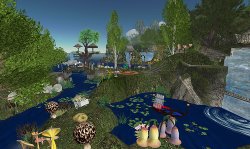Linden Lab responded to this question by introducing a MMOG with a sophisticated virtual economy system titled Second Life. Linden Lab promoted Second Life as a “3-D virtual world entirely built and owned by its residents” (Linden Lab, 2003). The virtual environment in Second Life is inspired by a popular simulation games, The Sims. Second Life was officially released in 2003 and the inhabitants of the virtual world had grown to 6,515,829 in May 2007. Similar to other MMOGs, Linden Lab’s role as a producer is merely to provide and maintain the space for users to access. The uniqueness of Second Life, however, is the fact that Linden Lab only constructed the basic landscape of the virtual environment. The construction of buildings and other elements in the virtual environment are almost fully outsourced to users of the game. A building tool is included in the software package of Second Life. Using the building tool, users of Second Life can modify landscapes and create buildings as well as items. Moreover, users can learn a scripting language called Linden Scripting Language (LSL), which allows users to add behaviours to the objects that they have created. Second Life users could learn about the language through LSL Wiki portal and a Second Life scripting forum. Second Life users can also purchase a manual for LSL from Linden Lab.

User transactions in Second Life by Linden Dollars (for more economical statistic in Second Life click here)
Although there are many resources available to assist Second Life user with learning LSL, the scripting language is a complex one and it could take hours of work to create objects within Second Life depending on the complexity of the object. Unlike Sony’s stance on the labour performed by Everquest users, Linden Lab recognises the labour of the users and therefore, Linden Lab rewarded the labour of the users by granting intellectual property rights to users for objects that they have created (Linden Lab, 2007). Furthermore, Linden Lab attempted to extend the recognition of intellectual property rights onto outside the game by allowing users to earn real income from trading objects. Users could trade their objects using Linden Dollar currency within the game and this currency could be exchanged into real money. This unique feature of Second Life had led some of the users to rely on incomes generated from the MMOG. Real world businesses had even started utilizing Second Life to promote their business. For instance, educational institutions created online presences in Second Life by building replicas of real campuses in Second Life (Shepherd, 2007). These educational institutions are considering the possibility of conducting distant learning through virtual classrooms in Second Life.


